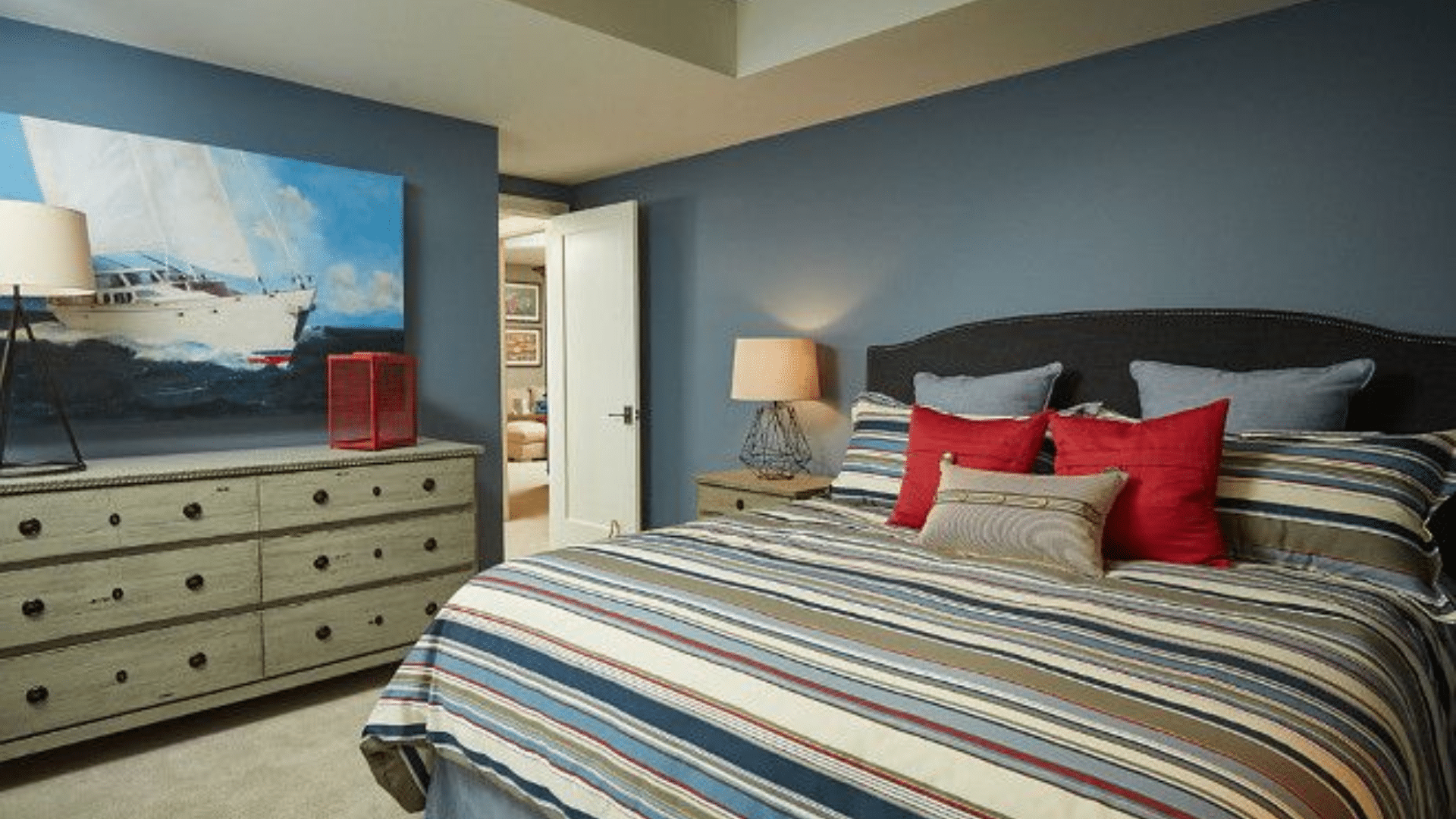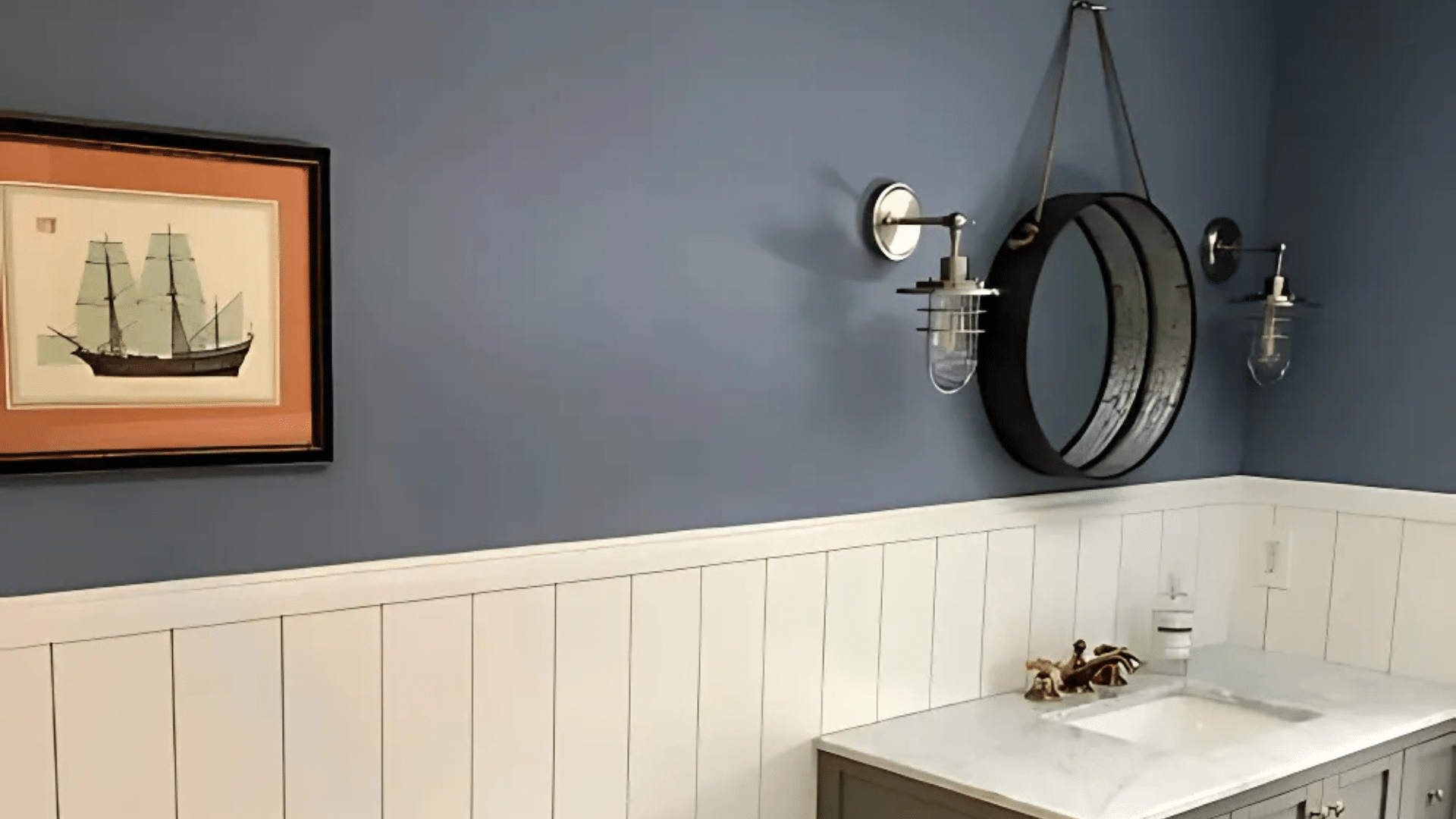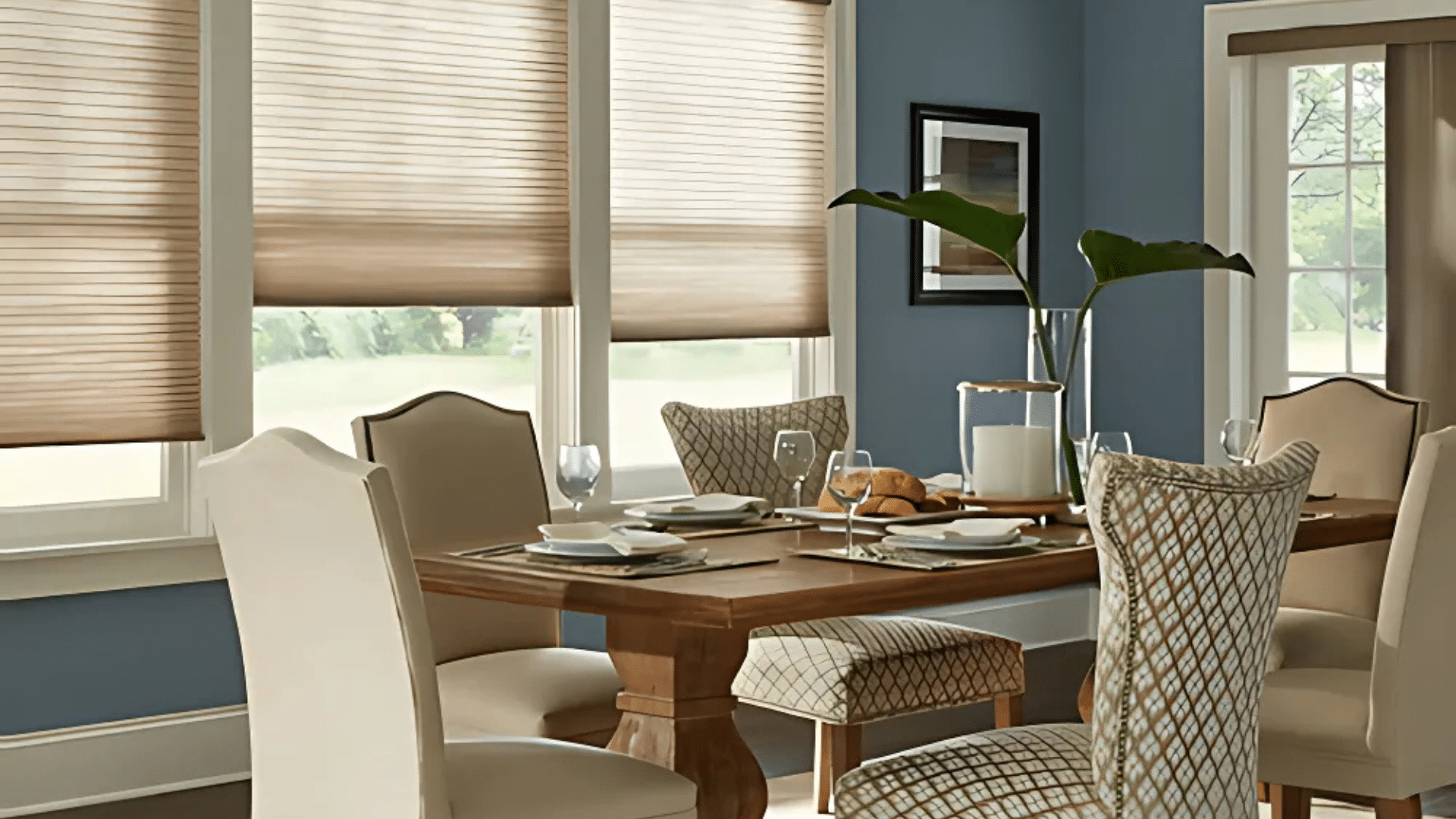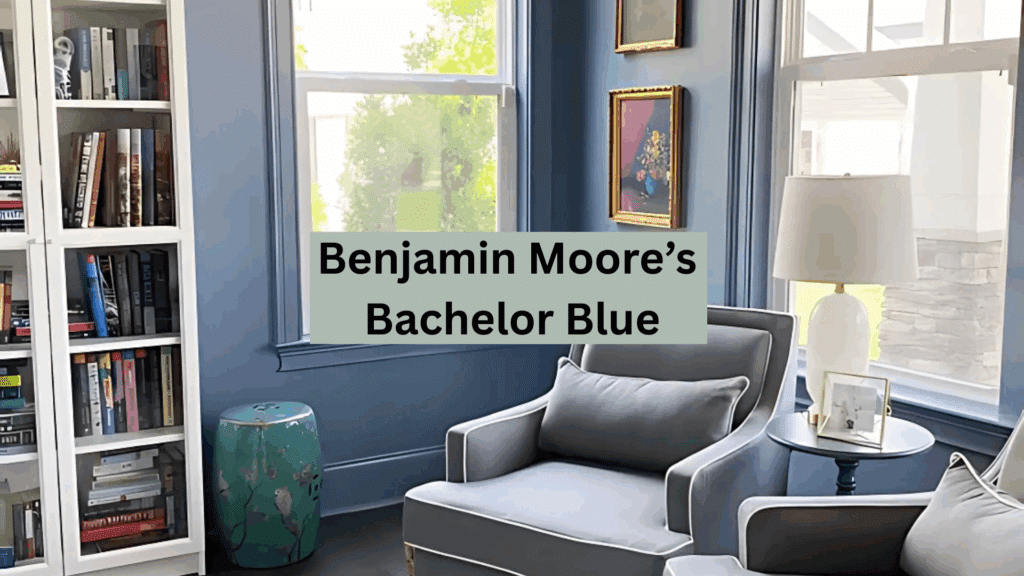Want to make your space feel bold without going too bright? Bachelor Blue by Benjamin Moore might be just the color you’re looking for.
This deep blue paint brings a strong look to any room. It’s not loud, but it grabs attention in a calm way. The rich tone adds weight and depth to your walls.
Bachelor Blue sits between navy and gray, giving it a steady feel that works in many homes. It looks different depending on the lighting—cooler in daylight, deeper at night.
People use it to bring contrast to light furniture or to add a moody touch to quiet spaces. It can stand alone or mix well with other neutral colors.
In this blog, you’ll learn what makes Bachelor Blue special, where it works best, and how to style your space around it.
What Kind of Color Is Bachelor Blue (1629)?

Bachelor Blue is a dark blue paint with a touch of gray. It’s not as bright as navy and not as cool as deep gray, but this mix gives it a strong but calm look.
It does not feel too warm or too cold. The color stays even, which helps it fit in many types of rooms. The gray in the base makes the blue softer and easier to live with.
On the color wheel, Bachelor Blue is close to true blue. But because of the gray, it feels quieter and steadier. It does not jump out, but it still has a bold look.
This color works well in bedrooms, dining rooms, and offices. It can be used all around a room or just on one wall. In both cases, it adds depth and helps the space feel more complete.
Bachelor Blue has an LRV of 23.52, so it reflects little light. This makes it a dark color that adds depth and mood, especially in low-light rooms.
Why Bachelor Blue Is the Perfect Choice for Your Space?
Bachelor Blue is a strong paint color that adds weight and style to any room. It works well when you want something darker than gray but not as bright as royal blue. This color helps create focus and gives walls a bold, clean look.
Let’s see why it works in so many settings:
- Great contrast with white trim, pale wood, and light furniture.
- Strong enough to stand out on a single accent wall or work across all four walls.
- Adds depth without being too dark for daily living.
- Brings out details in gold, brass, or black hardware.
- Works with many styles, including modern, rustic, and coastal rooms.
Bachelor Blue is easy to live with if you keep the rest of the room light and simple. It helps your space feel grounded and complete.
Depth and Undertones of Bachelor Blue: What You Need to Know

Bachelor Blue is not just any deep blue. It carries a touch of gray that gives it a calm and steady base. This mix helps it feel strong without being too bright or sharp. The color feels full and smooth, which adds richness to the walls without making them feel closed in.
Lighting plays a big role in how this color shows up. In natural daylight, it can look slightly cooler, giving off a sharp, crisp feel. Under warm indoor lights, it softens and becomes deeper. This change gives the room a little movement without being distracting.
Unlike some dark blues that lean toward green or purple, Bachelor Blue stays closer to true blue. The gray keeps it from feeling too bold, making it easier to match with other colors and finishes. If you want a deep color that adds weight without being too loud, this one works well.
The Psychology of Bachelor Blue: How It Affects Your Mood
Bachelor Blue brings a quiet strength to any room. It’s a deep color, but it doesn’t feel cold or distant. Instead, it helps create a space that feels calm and steady. People often say that deep blues help them feel more at ease, especially in rooms meant for rest or work.
This color also supports focus. It doesn’t pull your attention away, and it helps the room feel grounded. That’s why it’s a good choice for offices, study spaces, or bedrooms where you want a clear head. It also works well in rooms where you want to slow down after a long day.
There’s something about this kind of blue that feels safe and collected. It doesn’t try to take over the room. It just sits quietly in the background, helping everything else feel more settled.
Where Is Bachelor Blue Best Used in an Interior?

Bachelor Blue works in many rooms, but it’s best in spaces where bold color adds purpose. It can be used on one wall or across the whole room, depending on how much depth you want.
These are some of the best places where you can use it:
- Dining rooms: For a rich, quiet feel during meals.
- Bedrooms: To help create a calm space for rest.
- Home offices: To support focus and limit distractions.
- Living rooms: When balanced with light furniture and natural light.
- Accent walls: behind a bed, desk, or fireplace for a strong contrast.
Because this color is deep, it works best with light flooring and trim. It helps the room feel clean, clear, and balanced.
What Kind of Floors Would Look Best with Bachelor Blue?
Choosing the right floor is important when using a bold wall color like Bachelor Blue. The floor needs to support the paint without making the room feel too heavy or dark.
Here are good flooring options to consider:
- Light oak or whitewashed wood balances the dark tone of the walls.
- Mid-tone walnut for a warm, cozy contrast that doesn’t compete.
- Gray or soft beige tile for a clean and modern finish.
- Use a textured carpet in light gray or soft taupe to keep the space feeling open.
- Matte stone or concrete finishes if you want a more modern or urban look.
The goal is to let the walls make the statement while the floor supports the mood. These floor options help keep the room steady and easy to use.
How to Style and Decorate with Bachelor Blue?
Bachelor Blue is bold, so the rest of the room should help balance it. Light-colored furniture like white, beige, or pale wood keeps the space open and fresh. These soft tones help prevent the room from feeling too dark.
Warm metals such as brass or copper pair well with this color. They add a little shine without being too bright. Natural fabrics like cotton or linen in gray, cream, or tan work nicely for pillows, curtains, and bedding.
Stick to simple wall art and clean shapes. Use black or white frames to keep the focus on the walls. To add warmth, you can also bring in natural touches like light wood, jute rugs, or wicker baskets.
With the right mix of light colors and soft textures, Bachelor Blue can give your space a steady and relaxed look.
Lighting Tips for Bachelor Blue Walls

The way Bachelor Blue looks can change based on the light in the room. This color reacts to different types of light, which can make it feel cooler or warmer depending on the time of day and the kind of lighting you use. This is how lighting can affect Bachelor Blue:
- Natural light (daylight): Makes the color look cooler and more crisp, especially in rooms with large windows.
- Warm light (soft white bulbs): Adds a slight warmth and makes the blue feel deeper and cozier.
- Cool light (bright white or daylight bulbs): Brings out more of the gray in the paint, giving it a sharper, cooler tone.
- Low lighting or shaded rooms: This makes the color feel heavier and darker, which can be great for a more quiet or moody space.
- Bright overhead lighting: This can flatten the depth of the color, so it may help to add floor or table lamps for a softer light balance.
Lighting changes how this paint feels, so it’s a good idea to test it on your wall and check it at different times of day.
Bachelor Blue vs. Other Deep Blues: A Quick Comparison
Benjamin Moore has a few well-known deep blues, and it’s helpful to see how they differ. While Bachelor Blue has a strong and steady tone, colors like Hale Navy and Newburyport Blue offer their own look and feel.
| Paint Color | Tone | Undertone | Best Used In | Look and Feel |
|---|---|---|---|---|
| Bachelor Blue 1629 | Deep blue | Gray | Bedrooms, offices, feature walls | Calm, steady, bold |
| Hale Navy HC-154 | Very dark navy | Cool gray | Front doors, trim, full walls | Strong, classic, serious |
| Newburyport Blue HC-155 | Navy with warmth | Slight red | Dining rooms, studies, cabinets | Deep, rich, slightly warmer |
All three colors bring depth, but Bachelor Blue leans softer due to its gray base. It feels more relaxed and fits well in rooms where you want both color and calm.
Conclusion
Bachelor Blue by Benjamin Moore is a deep, grounded color that works well in many spaces. It gives your room a bold look without feeling too strong or too dark.
We looked at how this color reacts to different lighting and how it brings out calm and focus. It’s useful in bedrooms, living rooms, and offices where stillness and depth matter.
You also saw how it pairs with the right flooring and furniture. Soft wood, cool metals, and light fabrics can help bring balance to this bold paint color.
If you want a color that adds presence and a strong base, Bachelor Blue is a smart choice. It’s not just a color—it’s a way to bring structure and feeling into your home.
Now that you’ve seen how it looks and where it fits, you can decide if it’s the right pick for your next project.

